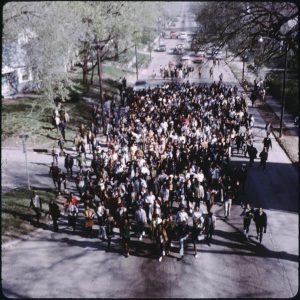In 1971-1972, the National Organization for Women, along with other women’s rights advocacy groups fought for passage of the Equal Rights Amendment. First written by Alice Paul in 1923, it was brought before Congress repeatedly over the ensuing decades. In 1971, the House of Representatives finally passed an updated version of the Amendment, which read as follows:
Section 1. Equality of rights under the law shall not be denied or abridged by the United States or by any state on account of sex.
Section 2. The Congress shall have the power to enforce, by appropriate legislation, the provisions of this article.
Section 3. This amendment shall take effect two years after the date of ratification.
The ERA eventually passed the Senate in the spring of 1972. As with any potential amendment, it then went to the states for ratification. It needed 38 states to ratify for passage, but only received 35 before the expiration of the ratification deadline. 5 other states eventually rescinded their ratification. The ERA still has support, and has been re-proposed numerous times. However the campaign of the 1970s remains its high water mark. LaBudde Special Collections houses some memorabilia related to the ERA crusade of the early 1970s. This post brings you a pamphlet with several “Songs to Pass the ERA By” (pictured below).
[ngg_images source=”galleries” container_ids=”1″ display_type=”photocrati-nextgen_basic_imagebrowser” ajax_pagination=”1″ order_by=”sortorder” order_direction=”ASC” returns=”included” maximum_entity_count=”500″]
The small collection of songs appears to have been compiled from contributors, whose names and locations are noted with each song. The songs in the brochure are drawn from several sources. First, “Shoulder to Shoulder” is derived from the song “March of the Women.” “March of the Women” was written in 1910 by two Englishwomen; composer Ethel Smyth and actress/writer Cecily Hamilton.
Both were active in the English Women’s Rights movement, and they wrote the song for the Women’s Social and Political Union, active in England 1903-1917. At the time it was written, the song was described as “at once a hymn and a call to battle.”
The “call to battle” theme continues with a song set to the US Army marching tune “Caissons Go Rolling Along.” Like “March of the Women,” it focuses on unity, or “sisterhood.” The other contribution to the NOW songbook that draws on American patriotism was a pro-ERA song set to the tune of “America the Beautiful.” This song is not a call to battle, instead it is a celebration of a brighter future in which men and women are “living in full equality.” The battle to pass the ERA coincided closely with the bicentennial of the United States, a point the NOW songwriters did not overlook. Both patriotic songs emphasized that 200 years had passed since the Declaration of Independence.
The little songbook is peppered with creative adaptations of popular songs as well. Two short sing-a-longs are set to “Brother John” (“Frère Jacques”) and “Row Your Boat.” A member of the Chicago branch of NOW submitted a pro-ERA song set to “Dinah Shore’s Chevy Song.”
Even though the jingle itself was a couple decades old, Dinah Shore would have been familiar to TV audiences from her numerous variety shows in the 1950s to her daily talk show during the 70s.. “Bella Ciao” takes a different approach, leveraging a less lighthearted subject. “Bella Ciao” (Italian for “Goodbye Beautiful”) is a song of resistance that was sung by anti-fascist Italian groups the 1943-1945 Italian Civil War. Again, a version of it is below. (LaBudde Special Collections is not responsible for any of these songs getting stuck in your head.)
These songs are evidence that ERA supporters saw themselves as part of a much wider movement. By borrowing from patriotic American traditions, they linked themselves with America’s past. They also looked worldwide, borrowing from longs of resistance and political movements written in other countries. Finally, the songwriters cleverly recycled one of the most famous commercial jingles ever written into a song for political action. This is a small document, but it encapsulates the vibrancy of the ERA movement and the NOW membership. Whether “Bella Ciao” or “Row Your Boat,” songs can become more than the sum of their parts, and music’s flexibility as a medium allows its use by groups across space and time.
Sources
YouTube
http://history.hanover.edu/courses/excerpts/336era.html
NOW Collection, MS-302, LaBudde Special Collections, University of Missouri-Kansas City.
Elizabeth Crawford, The Women’s Suffrage Movement: a Reference Guide, 1866–1928. (London: Routledge, 2001).

